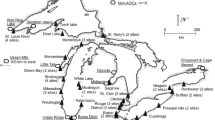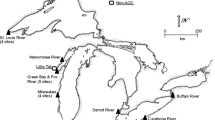Abstract
A site in northeastern Michigan, Oscoda Township, has some of the highest recorded exposure in birds to perfluorinated substances (PFASs) in the United States. Some egg and plasma concentrations at that location exceeded the lowest reproductive effect threshold established for two avian laboratory species. The objectives of this study were to determine whether there were reproductive effects or physiological responses in a model bird species, the tree swallow (Tachycineta bicolor), associated with this extremely high exposure to PFASs. The lack of exposure above background to other contaminants at this site allowed for an assessment of PFAS effects without the complication that responses may be caused by other contaminants. A secondary objective was to determine the distribution of PFASs in multiple tissue types to better understand and interpret residues in different tissues. This can best be done at highly exposed locations where tissue concentrations would be expected to be above detectable levels if they are present in that tissue. There were no demonstrable effects of PFAS exposure on reproduction nor on most physiological responses.



Similar content being viewed by others
References
AVMA (2013) AVMA guidelines for the euthanasia of animals, 2013th edn. American Veterinary Medical Association, Schaumburg
Beesoon S, Martin JW (2015) Isomer-specific binding affinity of perfluorooctanesulfonate (PFOS) and perfluorooactnoate (PFOA) to serum proteins. Environ Sci Technol 49:5722–5731. https://doi.org/10.1021/es505399w
Bermejo JL, Sauck WA, Atekwana EA (1997) Geophysical discovery of a new LNAPL plume at the former Wurtsmith AFB, Oscoda, Michigan. Groundw Monit Remediat 17:131–137. https://doi.org/10.1111/j.1745-6592.1997.tb01273
Boening DW (2000) Ecological effects, transport, and fate of mercury: a general review. Chemosphere 20:1335–1351
Butt CM, Berger U, Bossi R, Tomy GT (2010) Levels and trends of poly- and perfluorinated compounds in the arctic environment. Sci Total Environ 408:2936–2965
Clarke RK, Warwick RM (2001) Change in marine communities: an approach to statistical analysis and interpretation, 2nd edn. Plymouth Marine Laboratory, UK
Custer CM (2011) Swallows as a sentinel species for contaminant exposure and effect studies. In: Elliott JE, Bishop CA, Morrissey CA (eds) Wildlife ecotoxicology: forensic approaches, emerging topics in ecotoxicology: book, vol 3, pp 45–91. https://doi.org/10.1007/978-0-387-89432-4_3
Custer CM, Custer TW, Allen PD, Stromborg KL, Melancon NJ (1998) Reproduction and environmental contamination in tree swallows nesting in the Fox River drainage and Green Bay, Wisconsin, USA. Environ Toxicol Chem 17:1765–1987
Custer CM, Custer TW, Dummer PM, Munney KL (2003) Exposure and effects of chemical contaminants on tree swallows nesting along the Housatonic River, Berkshire County, Massachusetts, USA, 1998–2000. Environ Toxicol Chem 22:1605–1621
Custer CM, Custer TW, Schoenfuss HL, Poganski BH, Solem L (2012) Exposure and effects of perfluoroalkyl compounds on tree swallows nesting at Lake Johanna in eastcentral Minnesota, USA. Reprod Toxicol 33(4):556–562. https://doi.org/10.1016/j.reprotox.2011.01.005
Custer TW, Dummer PM, Custer CM et al (2013) Perfluorinated compound concentrations in great blue heron eggs near St. Paul, Minnesota USA in 1993 and 2010–2011. Environ Toxicol Chem 32:1077–1083. https://doi.org/10.1002/etc.2146
Custer CM, Custer TW, Dummer PM et al (2014) Exposure and effects of perfluoroalkyl substances in tree swallows nesting in Minnesota and Wisconsin, USA. Arch Environ Contam Toxicol 66:120–138. https://doi.org/10.1007/s00244-013-9934-0
Custer TW, Custer CM, Dummer PM et al (2017a) Organic contamination in tree swallow (Tachycineta bicolor) nestlings at United States and Binational Great Lakes Areas of Concern. Environ Toxicol Chem 36:735–748. https://doi.org/10.1002/etc.3598
Custer TW, Custer CM, Dummer PM (2017b) EROD activity, chromosomal damage, and oxidative stress in response to contaminant exposure to tree swallows (Tachycineta bicolor) nesting in Great Lakes Areas of Concern. Ecotoxicology 26:1392–1407
Custer CM, Custer TW, Etterson MA et al (2018) Reproductive success and contaminant associations in tree swallows (Tachycineta bicolor) used to assess a Beneficial Use Impairment in U.S. and Binational Great Lakes’ Areas of Concern. Ecotoxicology 27:457–476
Dauwe T, Van de Vijver K, De Coen W, Eens W (2007) PFOS levels in the blood and liver of a small insectivorous songbird near a fluorochemical plant. Environ Int 33:357–361
European Food Safety Authority (2008) Perfluorooctane sulfonate (PFOS), perfluorooctanoic acid (PFOA) and their salts. EFSA J 653:1–131
Gebbink WA, Letcher RJ (2012) Comparative tissue and body compartment accumulation and maternal transfer of eggs of perfluoroalkyl sulfonates and carboxylates in Great Lakes herring gulls. Environ Pollut 162:40–47
Giesy JP, Kannan K (2001) Global distribution of perfluorooctane sulfonate in wildlife. Environ Sci Technol 35:1339–1342
Groffen T, Lopez-Antia A, D’Hollander W et al (2017) Perfluoroalkylated acids in the eggs of great tits (Parus major) near a fluorochemical plant in Flanders, Belgium. Environ Pollut 228:140–148
Groffen T, Lasters R, Lopez-Antia A et al (2019) Limited reproductive impairment in a passerine bird species exposed along a perfluoroalkyl acid (PFAA) pollution gradient. Sci Total Environ 652:718–728
Han X, Snow TA, Kemper RA, Jepsen GW (2003) Binding of perfluorooctanoic acid to rat and human plasma proteins. Chem Res Toxicol 16:775–781
Haukås M, Berger U, Hop H et al (2007) Bioaccumulation of per-and polyfluorinated alkyl substances (PFAS) in selected species from the Barents Sea food web. Environ Pollut 148:360–371
Holmström KE, Berger U (2008) Tissue distribution of perfluorinated surfactants in common guillemot (Uria aalge) from the Baltic Sea. Environ Sci Technol 42:5879–5884
Kammann U, Lang T, Vobach M, Wosniok W (2005) Ethoxyresorufin-O-deethylase (EROD) activity in Dab (Limanda limanda) as biomarker for marine monitoring. Environ Sci Pollut Res 12:140–145
Kelly BC, Ikonomou MG, Blair JD (2009) Perfluoroalkyl contaminants in an arctic marine food web: trophic magnification and wildlife exposure. Environ Sci Technol 43:4037–4043
Liu C, Chang VWC, Gin KYH (2013) Environmental toxicity of PFCs: an enhanced integrated biomarker assessment and structure–activity analysis. Environ Toxicol Chem 32:2226–2233
Lohnes KL (2006) Impact of reconstructed wetlands on the tree swallow (Tachycineta bicolor). Master of Science, University of Maryland, College Park, MD
Lopez-Antia A, Dauwe T, Meyer J, Maes K, Bervoets L, Eens M (2017) High levels of PFOS in eggs of three bird species in the neighbourhood of a fluoro-chemical plant. Ecotoxicol Environ Saf 139:165–171
McNabb FMA, Jang DA, Larsen CT (2004) Does thyroid function in developing birds adapt to sustained ammonium perchlorate exposure? Toxicol Sci 82:106–113
Moody CA, Hebert GM, Strauss SH, Field JA (2003) Occurrence and persistence of perfluorooctanesulfonate and other perfluorinated surfactants in groundwater at a fire-training area at Wurtsmith Air Force Base, Michigan, USA. J Environ Monit 5:341–345
Newsted JJ, Jones PD, Coady K, Giesy JP (2005) Avian toxicity reference values for perfluorooctane sulfonate. Environ Sci Technol 39:9357–9362
Place BJ, Field JA (2012) Identification of novel fluorochemicals in aqueous film-forming foams used by the US military. Environ Sci Technol 46:7120–7127. https://doi.org/10.1021/es301465n
R Core Team (2015) R: a language and environment for statistical computing. R Foundation for Statistical Computing, Vienna
Rainio MJ, Kanerva M, Wahlberg N, Nikinmaa M, Eeva T (2012) Variation of basal EROD activities in ten passerine bird species: relationships with diet and migration status. PLoS ONE 7:e33926
Rüdel H, Müller J, Jürling H, Koschorreck J (2011) Survey of patterns, levels, and trends of perfluorinated compounds in aquatic organisms and bird eggs from representative German ecosystems. Environ Sci Pollut Res 18:1457–1470
Sanchez W, Piccini B, Ditche JM, Porcher JM (2008) Assessment of seasonal variability of biomarkers in three-spined stickleback (Gasterosteus aculeatus L.) from a low contaminated stream: Implication for environmental biomonitoring. Environ Int 34:791–798
Sleiderink HM, Beyer J, Everaarts JM, Boon JP (1995) Influence of temperature on cytochrome P450 1A in dab (Limanda limanda) from the Southern North Sea: results from field surveys and a laboratory study. Mar Environ Res 39:67–71
Stapleton MK, Robertson RJ (2006) Female tree swallow home-range movements during their fertile period as revealed by radio-tracking. Wilson J Ornithol 118:502–507
Verreault J, Houde M, Gabrielsen GW et al (2005) Perfluorinated alkyl substances in plasma, liver, brain, and eggs of glaucous gulls (Larus hyperboreus) from the Norwegian arctic. Environ Sci Technol 39:7439–7445
Ward S, Bryant DM (2006) Barn swallows Hirundo rustica form eggs mainly from current food intake. J Avian Biol 37:179–189
Weiss JM, Andersson PL, Lamoree MH et al (2009) Competitive binding of Poly- and perfluorinated compounds to the thyroid hormone transport protein transthyretin. Toxicol Sci 109:206–216
Acknowledgements
The authors thank Greg E. Berner, Dana Shugart, Paul Thompson, Matthew Lark, M. Lovelace, C. Brooks, and B. Fetting for weekly nest checks, the U.S. Forest Service, Huron-Manistee National Forest, MI for access to the site, and Mike Boogaard, and 2 anonymous reviewers for comments on earlier versions of this manuscript. Funding was provided by U.S. Geological Survey and Great Lakes Restoration Initiative.
Author information
Authors and Affiliations
Corresponding author
Electronic supplementary material
Below is the link to the electronic supplementary material.
Rights and permissions
About this article
Cite this article
Custer, C.M., Custer, T.W., Delaney, R. et al. Perfluoroalkyl Contaminant Exposure and Effects in Tree Swallows Nesting at Clarks Marsh, Oscoda, Michigan, USA. Arch Environ Contam Toxicol 77, 1–13 (2019). https://doi.org/10.1007/s00244-019-00620-1
Received:
Accepted:
Published:
Issue Date:
DOI: https://doi.org/10.1007/s00244-019-00620-1




